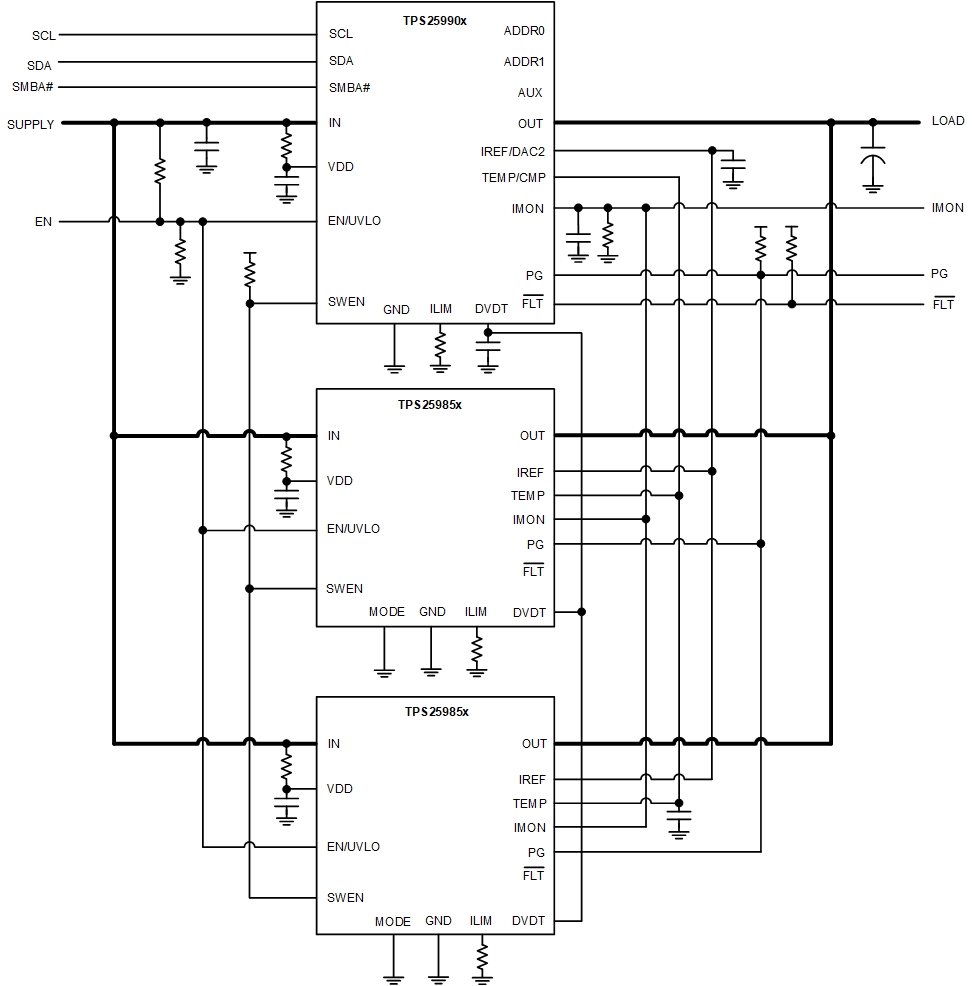SLVSGG4B september 2022 – june 2023 TPS25990
PRODUCTION DATA
- 1
- 1 Features
- 2 Applications
- 3 Description
- 4 Revision History
- 5 Description (continued)
- 6 Pin Configuration and Functions
-
7 Specifications
- 7.1 Absolute Maximum Ratings
- 7.2 ESD Ratings
- 7.3 Recommended Operating Conditions
- 7.4 Thermal Information
- 7.5 Electrical Characteristics
- 7.6 Logic Interface DC Characteristics
- 7.7 Telemetry
- 7.8 PMBus Interface Timing Characteristics
- 7.9 External EEPROM Interface Timing Characteristics
- 7.10 Timing Requirements
- 7.11 Switching Characteristics
- 7.12 Typical Characteristics
-
8 Detailed Description
- 8.1 Overview
- 8.2 Functional Block Diagram
- 8.3
Feature Description
- 8.3.1 Undervoltage Protection
- 8.3.2 Insertion Delay
- 8.3.3 Overvoltage Protection
- 8.3.4 Inrush Current, Overcurrent, and Short-Circuit Protection
- 8.3.5 Single Point Failure Mitigation
- 8.3.6 Analog Load Current Monitor (IMON)
- 8.3.7 Overtemperature Protection
- 8.3.8 Analog Junction Temperature Monitor (TEMP)
- 8.3.9 FET Health Monitoring
- 8.3.10 General Purpose Digital Input/Output Pins
- 8.3.11 Stacking Multiple eFuses for Unlimited Scalability
- 8.3.12 General Purpose Comparators
- 8.3.13 Output Discharge
- 8.3.14
PMBus® Digital Interface
- 8.3.14.1 PMBus® Device Addressing
- 8.3.14.2 SMBus Protocol
- 8.3.14.3 SMBus™ Message Formats
- 8.3.14.4 Packet Error Checking
- 8.3.14.5 Group Commands
- 8.3.14.6 SMBus™ Alert Response Address (ARA)
- 8.3.14.7
PMBus® Commands
- 8.3.14.7.1
Detailed Descriptions of PMBus® Commands
- 8.3.14.7.1.1 OPERATION (01h, Read/Write Byte)
- 8.3.14.7.1.2 CLEAR_FAULTS (03h, Send Byte)
- 8.3.14.7.1.3 RESTORE_FACTORY_DEFAULTS (12h, Send Byte)
- 8.3.14.7.1.4 STORE_USER_ALL (15h, Send Byte)
- 8.3.14.7.1.5 RESTORE_USER_ALL (16h, Send Byte)
- 8.3.14.7.1.6 BB_ERASE (F5h, Send Byte)
- 8.3.14.7.1.7 FETCH_BB_EEPROM (F6h, Send Byte)
- 8.3.14.7.1.8 POWER_CYCLE (D9h, Send Byte)
- 8.3.14.7.1.9 MFR_WRITE_PROTECT (F8h, Read/Write Byte)
- 8.3.14.7.1.10 CAPABILITY (19h, Read Byte)
- 8.3.14.7.1.11 STATUS_BYTE (78h, Read Byte)
- 8.3.14.7.1.12 STATUS_WORD (79h, Read Word)
- 8.3.14.7.1.13 STATUS_OUT (7Ah, Read Byte)
- 8.3.14.7.1.14 STATUS_IOUT (7Bh, Read Byte)
- 8.3.14.7.1.15 STATUS_INPUT (7Ch, Read Byte)
- 8.3.14.7.1.16 STATUS_TEMP (7Dh, Read Byte)
- 8.3.14.7.1.17 STATUS_CML (7Eh, Read Byte)
- 8.3.14.7.1.18 STATUS_MFR_SPECIFIC (80h, Read Byte)
- 8.3.14.7.1.19 STATUS_MFR_SPECIFIC_2 (F3h, Read Word)
- 8.3.14.7.1.20 PMBUS_REVISION (98h, Read Byte)
- 8.3.14.7.1.21 MFR_ID (99h, Block Read)
- 8.3.14.7.1.22 MFR_MODEL (9Ah, Block Read)
- 8.3.14.7.1.23 MFR_REVISION (9Bh, Block Read)
- 8.3.14.7.1.24 READ_VIN (88h, Read Word)
- 8.3.14.7.1.25 READ_VOUT (8Bh, Read Word)
- 8.3.14.7.1.26 READ_IIN (89h, Read Word)
- 8.3.14.7.1.27 READ_TEMPERATURE_1 (8Dh, Read Word)
- 8.3.14.7.1.28 READ_VAUX (D0h, Read Word)
- 8.3.14.7.1.29 READ_PIN (97h, Read Word)
- 8.3.14.7.1.30 READ_EIN (86h, Block Read)
- 8.3.14.7.1.31 READ_VIN_AVG (DCh, Read Word)
- 8.3.14.7.1.32 READ_VIN_MIN (D1h, Read Word)
- 8.3.14.7.1.33 READ_VIN_PEAK (D2h, Read Word)
- 8.3.14.7.1.34 READ_VOUT_AVG (DDh, Read Word)
- 8.3.14.7.1.35 READ_VOUT_MIN (DAh, Read Word)
- 8.3.14.7.1.36 READ_IIN_AVG (DEh, Read Word)
- 8.3.14.7.1.37 READ_IIN_PEAK (D4h, Read Word)
- 8.3.14.7.1.38 READ_TEMP_AVG (D6h, Read Word)
- 8.3.14.7.1.39 READ_TEMP_PEAK (D7h, Read Word)
- 8.3.14.7.1.40 READ_PIN_AVG (DFh, Read Word)
- 8.3.14.7.1.41 READ_PIN_PEAK (D5h, Read Word)
- 8.3.14.7.1.42 READ_SAMPLE_BUF (D8h, Block Read)
- 8.3.14.7.1.43 READ_BB_RAM (FDh, Block Read)
- 8.3.14.7.1.44 READ_BB_EEPROM (F4h, Block Read)
- 8.3.14.7.1.45 BB_TIMER (FAh, Read Byte)
- 8.3.14.7.1.46 PMBUS_ADDR (FBh, Read/Write Byte)
- 8.3.14.7.1.47 VIN_UV_WARN (58h, Read/Write Word)
- 8.3.14.7.1.48 VIN_UV_FLT (59h, Read/Write Word)
- 8.3.14.7.1.49 VIN_OV_WARN (57h, Read/Write Word)
- 8.3.14.7.1.50 VIN_OV_FLT (55h, Read/Write Word)
- 8.3.14.7.1.51 VOUT_UV_WARN (43h, Read/Write Word)
- 8.3.14.7.1.52 VOUT_PGTH (5Fh, Read/Write Word)
- 8.3.14.7.1.53 OT_WARN (51h, Read/Write Word)
- 8.3.14.7.1.54 OT_FLT (4Fh, Read/Write Word)
- 8.3.14.7.1.55 PIN_OP_WARN (6Bh, Read/Write Word)
- 8.3.14.7.1.56 IIN_OC_WARN (5Dh, Read/Write Word)
- 8.3.14.7.1.57 VIREF (E0h, Read/Write Byte)
- 8.3.14.7.1.58 GPIO_CONFIG_12 (E1h, Read/Write Byte)
- 8.3.14.7.1.59 GPIO_CONFIG_34 (E2h, Read/Write Byte)
- 8.3.14.7.1.60 ALERT_MASK (DBh, Read/Write Word)
- 8.3.14.7.1.61 FAULT_MASK (E3h, Read/Write Word)
- 8.3.14.7.1.62 DEVICE_CONFIG (E4h, Read/Write Word)
- 8.3.14.7.1.63 BB_CONFIG (E5h, Read/Write Byte)
- 8.3.14.7.1.64 OC_TIMER (E6h, Read/Write Byte)
- 8.3.14.7.1.65 RETRY_CONFIG (E7h, Read/Write Byte)
- 8.3.14.7.1.66 ADC_CONFIG_1 (E8h, Read/Write Byte)
- 8.3.14.7.1.67 ADC_CONFIG_2 (E9h, Read/Write Byte)
- 8.3.14.7.1.68 PK_MIN_AVG (EAh, Read/Write Byte)
- 8.3.14.7.1.69 VCMPxREF (EBh, Read/Write Byte)
- 8.3.14.7.1.70 PSU_VOLTAGE (ECh, Read/Write Byte)
- 8.3.14.7.1.71 CABLE_DROP (EDh, Read/Write Byte)
- 8.3.14.7.1.72 GPDAC1 (F0h, Read/Write Byte)
- 8.3.14.7.1.73 GPDAC2 (F1h, Read/Write Byte)
- 8.3.14.7.1.74 INS_DLY (F9h, Read/Write Byte)
- 8.3.14.7.1
Detailed Descriptions of PMBus® Commands
- 8.3.14.8 Analog-to-digital Converter
- 8.3.14.9 Digital-to-analog Converters
- 8.3.14.10 DIRECT format Conversion
- 8.3.14.11 Blackbox Fault Recording
- 8.4 Device Functional Modes
- 9 Application and Implementation
- 10Device and Documentation Support
- 11Mechanical, Packaging, and Orderable Information
Package Options
Mechanical Data (Package|Pins)
- RQP|26
Thermal pad, mechanical data (Package|Pins)
Orderable Information
3 Description
The TPS25990 is an integrated, high-current circuit protection and power management device in a small package. The device provides multiple protection modes using very few external components and is a robust defense against overloads, short circuits, and excessive inrush current.
The integrated PMBus® interface allows a host controller to monitor, control and configure the system in real-time. Key system parameters can be read back by remote telemetry. Various protection, warning thresholds and coefficients can be configured through PMBus® or stored in non-volatile configuration memory. Blackbox fault recording feature helps in the debugging of field failures and returns.
The device can be used as a standalone eFuse, or connected as a primary controller in a parallel eFuse configuration for higher current support. All devices actively synchronize their operating state and share current during start-up and steady state to avoid over-stressing some of the devices which can result in premature or partial shutdown of the parallel chain.
| PART NUMBER | PACKAGE(1) | PACKAGE SIZE |
|---|---|---|
| TPS25990ARQPR | RQP (QFN, 26) | 4.50 mm × 5.00 mm |
 Simplified Schematic
Simplified Schematic